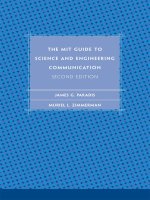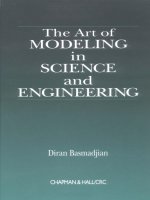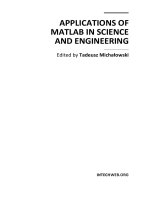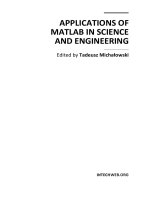MATHEMATICAL METHOD IN SCIENCE AND ENGINEERING Episode 7 pdf
Bạn đang xem bản rút gọn của tài liệu. Xem và tải ngay bản đầy đủ của tài liệu tại đây (2.63 MB, 40 trang )
OPERATIONS WITH GENERAL TENSORS
193
Similarly, the covariant derivative
of
a
contravariant vector is defined
as
(10.208)
The covariant derivative is also shown
as
a,,
that
is,
ajui
=
ui;j.
The covariant
derivative
of
a
higher-rank tensor is obtained by treating each index
at
a
time
as
(10.209)
Covariant derivatives distribute like ordinary derivatives, that
is,
(AB).,
=
A,;B
+
AB,i
(10.210)
and
(uA
+
bB);i
=
uA;~
+
bB,i
(10.211)
where
A
and
B
are tensors
of
arbitrary rank and
a
and
b
are scalars.
10.9.8
Some
Covariant Derivatives
In the following we
also
show equivalent ways
of
writing these operations
commonly encountered in the literature.
1.
Using definition Equation (10.123) we can write the covariant derivative
of
a
scalar function
@
as
an ordinary derivative:
This is also the covariant component
of
the gradient
(9.);
.
(10.212)
(10.213)
2.
Using the symmetry
of
Christoffel symbols, the curl
of
a
vector field
3
can be defined
as
the second-rank tensor
(bx
3).
,
=
aiv,
-
a,vj
=
vi;j
-
vj;i
(10.214)
23
(10.215)
194
COORDINATES AND TENSORS
Note that because we have used the symmetry of the Christoffel symbols,
the curl operation can only
be
performed on the covariant components
of
a
vector.
3. The covariant derivative of the metric tensor is zero:
akgij
=
&;k
=
0,
(10.216)
with Equation (10.209) and the definition
of
Christoffel symbols the
proof
is
straightforward.
4.
A
frequently
used
property of the Christoffel symbol
of
the second kind
is
In the derivation we use the result
from the theory of matrices, where
g
=
det
gij.
5.
We can now define covariant divergence
as
7.3
=
diUi
=
u:.
7%
(10.217)
(10.218)
(10.219)
(10.220)
(10.221)
If
vz
is
a
tensor density
of
weight
+1,
divergence becomes
V.v+==U!Z
(=
did),
(10.222)
which is again
a
scalar density
of
weight
fl.
6.
Using Equation (10.213) we write the contravariant component
of
the
gradient
of
a
scalar function
as
We can now define the Laplacian
as
a
scalar field:
(10.223)
(10.224)
OPERATIONS
WITH
GENERAL TENSORS
195
10.9.9
Riemann Curvature Tensor
Let us take the covariant derivative
of
ui
twice. The difference
ui;jk
-
Ui;kj
can be written
as
(10.226)
where
Rijk
is
the fourth-rank
Riemann curvature tensor,
which plays
a
central role in the structure of Riemann spaces:
Three of the symmetries
of
the Riemann curvature tensor can
be
summarized
as
(10.229)
(10.230)
(10.231)
Actually, there
is
one more symmetry that we will not discuss. The signifi-
cance of the Riemann curvature tensor is, that all
of
its components vanish
only in flat space, that is we cannot find
a
coordinate system where
Rijkl
=
0
(10.232)
unless the space is truly flat.
which is obtained from
Rijkl
by contracting its indices
as
An important scalar in Riemann spaces is the
Riemann curvature scalar,
R
==
y'lgikR
ajkl
=
jLRi
221
=
Ra.,3
32
.
(10.233)
Note that
&jkl
=
0
implies
R
=
0,
but not vice versa.
Example
10.1.
Laphcian
as
a
scalar
field:
We consider the line element
ds2
=
dr2
+
r2d2
+
r2
sin2
Bd$,
(10.234)
where
x1
=
r,
x2
=
8,
x3
=
4
(10.235)
and
911
=
1,
g22
=
r2,
933
=
r
2
sin28.
(10.236)
196
COORDINATES AND TENSORS
Contravariant components
9'3
are:
(10.237)
Using Equation (10.225) and
g
=
r4
sin2
0,
we can write the Laplacian
as
(10.238)
- -
1
["
(r2sinog)
+ae
d
(TaB)
r2sinOaW
+a
(WE)]
After simplifying, the Laplacian
is
obtained as
r2sin6
dr
34
r2sin28
a4
'
(10.239)
Here we have obtained
a
well-known formula in
a
rather straightfor-
ward manner, demonstrating the advantages of the tensor formalism.
Note that even though the components
of
the metric tensor depend on
position [Eq. (10.236)], the curvature tensor is zero,
Rijki
=
0;
(10.240)
thus the space
of
the line element
[Eq.
(10.234)] is
flat.
However, for
the metric
it
can
be
shown that not
all
the components of
Rijkl
vanish. In fact, this
line element gives the distance between two infinitesimally close points
on the surface of
a
hypersphere (S-3) with constant radius
&.
10.9.10
Geodesics
Geodesics are defined
as
the shortest paths between two points in
a
given
geometry. In
flat
space they are naturally the straight lines. We can gener-
alize the concept of straight lines
as
curves whose tangents remain constant
along the curve. However, the constancy
is
now with respect to the covariant
derivative. If we parametrize an arbitrary curve in terms of arclength
s
as
SPACETIME AND FOUR-TENSORS
197
its tangent vector will be given
as
.
dxi
ta
=
-_
ds
(10.243)
For
geodesics the covariant
equation of geodesics as
dX-3
t"-
J
ds
or
as
derivative of
ti
must be zero; thus we obtain the
=
[-$
+
{31i}t"]
g
=
0
-
&xi
+
{
}dxj
dx"
=
0.
ds2
jk
ds
ds
(10.244)
(10.245)
10.9.11
lnvariance and Covariance
We have seen that scalars preserve their value under general coordinate trans
formations. Certain other properties like the magnitude of a vector and the
trace of
a
second-rank tensor
also
do not change under general coordinate
transformations. Such properties are called
invariants.
They are very im-
portant in the study of the coordinate-independent properties of a system.
An important property of tensors is that tensor equations preserve their
form under coordinate transformations.
For
example, the tensor equation
transforms into
(10.247)
This
is
called
covariance.
Under coordinate transformations individual com-
ponents of tensors change; however, the form of the tensor equation remains
the same. One of the early uses for tensors in physics was in searching and
expressing the coordinate independent properties of crystals. However, the
covariance
of
tensor equations reaches its full potential only wit$h the intro-
duction of the spacetime concept and the special and the general theories of
relativity.
10.10
SPACETIME
AND
FOUR-TENSORS
10.10.1
Minkowski Spacetime
In Newton's theory, the energy of a freely moving particle is given by the
well-known expression for kinetic energy:
E=-mu.
12
(10.248)
2
198
COORDINATES AND TENSORS
fig.
10.8
Minkowski
spacetime
Because there is no limit
to
the energy that one could pump into
a
system, this
formula implies that in principle one could accelerate particles
to
any desired
velocity.
In classical physics this makes it possible
to
construct infinitely
fast
signals
to
communicate with the other
parts
of
the universe. Another
property
of
Newton’s theory is that time is universal
(or
absolute), that is,
identical clocks carried by moving observers, uniform
or
accelerated, run
at
the same rate. Thus once two observers synchronize their clocks, they will
remain synchronized for ever. In Newton’s theory this allows
us
to
study
systems with moving
parts
in terms
of
a
single (universal) time parameter.
With the discovery
of
the special theory
of
relativity it became clear that
clocks carried by moving observers run
at
different rates; thus using
a
single
time parameter for all observers is not possible.
After Einstein’s introduction
of
the special theory
of
relativity another
remarkable contribution toward the understanding
of
time came with the
introduction
of
the spacetime concept by Minkowski. Spacetime not only
strengthened the mathematical foundations
of
special relativity but also paved
the way
to
Einstein’s theory
of
gravitation
.
Minkowski spacetime is obtained by simply adding
a
time axis orthogonal
to
the Cartesian axis, thus treating time
as
another coordinate (Fig.
10.8).
A
point in spacetime corresponds
to
an event. However, space and time are also
fundamentally different and cannot be treated symmetrically.
For
example,
it
is
possible
to
be
present
at
the same place
at
two different times; however, if
we reverse the roles
of
space and time, and if space and time were symmetric,
then it would also mean that we could
be
present
at
two different places
at
the
SPACETIME AND FOUR-TENSORS
199
same time.
So
far
there is no evidence for this, neither in the micro- nor in the
macro-realm. Thus, in relativity even though space and time are treated on
equal footing
as
independent coordinates, they are not
treated
symmetrically.
This is evident in the Minkowski line element:
ds)’
=
c2dt2
-
dx)’
-
dy2
-
dZ2,
(10.249)
where the signs
of
the spatial and the time coordinates
are
different.
It is
for
this reason that Minkowski spacetime is called
pseudo-Euclidean.
In
this line element
c
is the speed
of
light representing the maximum velocity
in nature. An interesting property
of
the Minkowski spacetime is that two
events connected by light rays, like the emission
of
a
photon from one galaxy
and its subsequent absorption in another, have zero distance between them
even though they
are
widely separated in spacetime.
10.10.2
In Minkowski spacetime there are many different ways
to
chotlse the orienta-
tion
of
the coordinate axis. However,
a
particular
group
of
coordinate systems,
which are related
to
each other by linear transformations
of
the form
Lorentz Transformation and
the
Theory
of Special Relativity
9
=
ugzo
+
ay
+
a&)’
+
4.3
z1
=
u;zo
+
a;21
+
up
+
4x3
2)’
=
+
uqd
+
a;x2
+
a3r3
z3
=
u;.o
+
a;z1
+
u;2
+
4.3
(10.250)
and which also preserve the quadratic form
(2))’
-
(d))’
-
(2))’-
(23))’,
(10.251)
have been extremely useful in special relativity. In these equations we have
written
zo
=
ct
to
emphasize the fact that time is treated
as
another coordi-
nate.
In 1905 Einstein published his celebrated paper on the special theory
of
relativity, which is based on two postulates:
First postulate
of
relativity:
It is impossible to detect
or
measure uniform
translatory motion
of
a
system in free space.
Second postulate
of
relativity:
The speed
of
light in free space
is
the
maximum velocity in the universe, and it is the same for all uniformly
moving observers.
In special relativity two inertial observers
K
and
E,
where
is moving
uniformly with the velocity
21
along the common direction
of
the
d-
and
200
COORDINATES AND TENSORS
x3
23
fig.
10.9
Lorenta
transformations
?$-axes are related by the Lorentz transformation
(Fig.
10.9):
1
V
2J
=
J
[."
-
(,)
x']
1
-
u2/c2
1
V
-1
z
-
-
J
[-(,)."+x']
1
-
u2/c2
(10.252)
(10.253)
(10.254)
(10.255)
-2
-
2
x -x
2=x.
3
Inverse transformation is obtained by replacing
u
with
-v
as
V
zo
=
d-
[
TO+
(;)
2'1
1
-
v2/c2
z
1
=
d-
1
[( )3?+"1]
U
1
-
v2/c2
If the axis in
K
and
R
remain parallel but the velocity
?i'
of
(10.256)
(10.257)
(10.258)
(10.259)
ame
?T
in frame
K
is
arbitrary in direction, then the Lorentz transformation
is
generalized
as
(10.260)
(10.261)
8
=
y
[xo-
(3.34
SPACETIME AND FOUR-TENSORS
201
We have written
y
=
l/Jm
and
3
=
3/c.
10.10.3
Two immediate and important consequences of the Lorentz transformation
equations
[Eqs.
(10.252-10.255)]
are
the time dilation and length contraction
formulas, which are given
as
Time Dilation and Length Contraction
(10.262)
212
C2
AT
=
At(1-
-)1/2
and
respectively. These formulas relate the time and the space intervals measured
by two inertial observers
?7
and
K.
The second formula is also known as the
Lorentz contraction. The time dilation formula indicates that clocks carried
by moving observers run slower compared to the clocks
of
the observer at
rest. Similarly, the Lorentz contraction indicates that meter sticks carried by
a
moving observers appear shorter to the observer at
rest.
10.10.4
Addition
of
Velocities
Another important consequence of the Lorentz transformation is the formula
for the addition
of
velocities, which relates the velocities measured in the
K
and
1T
frames by the formula
(10.264)
dx
where
u1
=
-
and
a'
=
are the velocities measured in the
K
and the
-
dt
dt
K
frames, respectively. In the limit
as
c
f
03,
this formula reduces to the
well-known Galilean result
u1
=ti' +v.
(10.265)
It is clear from Equation (10.264) that even if we
go
to
a
frame moving with
the speed of light, it
is
not possible to send signals faster than
c.
If
the axes in
K
and
??
remain parallel, but the velocity
3
of
frame
1T
in frame
K
is
arbitrary in direction, then the parallel and the perpendicular
components of velocity transform
as
(10.266)
(10.267)
202
COORDINATES AND TENSORS
In this notation
UII
and
31
refer to the parallel and perpendicular components
with respect to
d
and
y
=
(1
-
Y~/c~)-~/~.
10.10.5
Four-Tensors
in
Minkowski
Spacetime
From the second postulate
of
relativity, the invariance of the speed
of
light
means
3
3
(10.268)
This can also be written
as
7japdEadZp
=
gapdxadxB
=
0,
(
10.269)
where the metric of the Minkowski spacetime
is
10
0
-
ga(3
=
gap
=
[
i
;
[I
i]-
We use the notation where the Greek indices take the values 0,1,2,3 and the
Latin indices run through 1,2,3.
Note
that even though the Minkowski space
time is flat, because
of
the reversal
of
sign
for
the spatial components it
is
not
Euclidean; thus the covariant and the contravariant indices differ in space
time. Contravariant metric components can be obtained using (Gantmacher)
(10.270)
(10.271)
as
10
0 0
gap=
[
1.
(10.272)
Similar to the position vector in Cartesian coordinates we can define
a
position
vector
r
in Minkowski spacetime
as
r
=
xa
=
(xo,x',x2,x3)
(10.273)
=
(xO,T),
where
r
defines the time and the position of an event. In terms
of
linear
transformations
[Eq.
(10.250)]
xa
transforms
as
(10.274)
-a
x
=a;xP.
SPACETIME AND FOUR-TENSORS
203
For
the Lorentz transformations
[Eqs.
(10.252-10.255) and (10.260-10.261)],
a$
are
given respectively
as
and
a;
=
(10.275)
.
(10.276)
For
the general linear transformation
[Eq.
(10.250)] matrix elements
a$
can
be obtained by using
dZa
dxp
a;
=
(10.277)
In Minkowski spacetime the distance between two infinitesimally close points
(events) can be written
as
ds2
=
dxadxa
=
(dx')'
-
(d~')~
-
(d~')~
-
(dz3)'
=
gaodxadxP.
(10.278)
In another inertial frame this becomes
Cts2
=
gaoedE@.
(10.279)
Using Equations (10.270) and (10.274) we can write this
as
~2
=
[gaoa~ag]
dx~dz6
.
(10.280)
If we restrict ourselves to transformations that preserve the length
of
a
vector
we obtain the relation
[&p";'L?j]
=
gra-
(10.281)
This
is
the analog
of
the orthogonality relation [Eq. (10.38)) The position
vector in Minkowski spacetime
is
called
a
four-vector,
and its components
transform
as
Zn
=
agxo,
where its magnitude is
a
four-scalar.
204
COORDINATES AND TENSORS
An arbitrary four-vector
A
=A"
=
(Ao,
A',
A2,A3),
(10.282)
is defined as a vector that transforms like the posit,ion vector
x"
as
-a
A
=a;AP.
(10.283)
For
two four-vectors
A"
and
B"
their scalar product is a
four-scalar,
which
is defined
as
In general all tensor operations defined
for
the general tensors are valid in
Minkowski spacetime with the Minkowski metric
[Eq.
(10.270)]. Higher-rank
four-tensors
can also be defined
as
-a1
"2 .
To1
Pz
. . .
(10.285)
10.10.6
Four-Velocity
Paths of observers in spacetime are called
worldlines
(Fig. 10.10). Because
spacetime increments form
a
four-vector
dx",
which transforms
as
dii?
=
J-
1
jdxo
-
(9>
dx']
1
-
v2/c2
&'
=
J
1
[-
(;)
2,
dxo
+
dx']
1
-
v2/c2
(10.286)
(10.287)
(10.288)
(10.289)
ds
we divide
dx"
with
a
scalar
dr
=
-,
called the
proper time,
to obtain the
four-velocity vector as
C
dx"
dr
U"
=
(10.290)
SPACETIME
AND
FOUR-TENSORS
205
Fig.
10.10
Worldlines
and
four-velocity
Similarly we can define four-acceleration
as
du"
dr
aa
=
-
d2xa
d.r2
'
-
From the line element
[Eq.
(10.278)], it
is
seen that the proper time
&=-=
ds
(
I
$&,
C
is
the time that the clocks carried by moving observers measure.
10.10.7
Four-Momentum and Conservation
Laws
Using four-velocity, we can define
a
four-momentum as
pa
=
mOua
dx,
dr
=
mo-,
(10.291)
(10.292)
(10.293)
(10.294)
where
~TQ
is the invariant rest mass of the particle. We can now express the
energy and momentum conservation laws covariantly
as
the invariance
of
the
magnitude of the four-momentum
as
pap,
=
muZLaua
=
const.
(10.295)
206
COORDINATES AND TENSORS
To
evaluate the constant value of
pupu
we use the line element and the defi-
nition
of
the proper time to find
uUuu
as
ds2
=
c2dt2
-
(d~’)~
-
(d~~)~
-
(d~~)~,
(10.296)
(10.297)
c2
=
uau,.
Thus.
(10.298)
(
10.299)
U
22
P
pU
=
m0c
.
Writing the left-hand side
of
Equation
(10.299)
explicitly we get
1
(10.300)
(10.301)
0
P
Po
+
P
Pl
+
P2P2
+
P3P3
=
m;c2
(pol2
-
(p1l2
-
(p212
-
(p3))”
=
mgc2.
Spatial components
of
the four-momentum are
dxi
pz
=
mo-,
dT
i
=
1,2,3 (10.302)
(10.303)
U1
=
Using this in Equation
(10.301)
we obtain
(1
-
u2/c2)
or
(1
-
?l2lc2
U”C2)
1
l?
i
po=moc
1+
In order to interpret
po,
we take its classical limit
as
(10.304)
(
10.305)
(10.306)
(
10.307)
(10.308)
SPACETIME AND FOUR-TENSORS
207
The second term inside the square brackets is the classical expression for
the kinetic energy of
a
particle; however, the first term
is
new to Newton's
mechanics. It indicates that free particles, even when they are
at
rest, have
energy due to their rest mass. This is the Einstein's famous formula
E=WC,
2
(10.309)
which indicates that mass and energy could
be
converted into each other. We
can now interpret the time component
of
the four-momentum
as
E/c,
where
E
is the total energy
of
the particle; thus the components of
p"
become
E.
p"
=
(1,
mothZ).
(10.310)
We now write the conservation of four-momentum equation
as
E2
m;u2
22
=mot.
p"p,
=
-
-
-
c2
(I
-
$)
Defining
(10.31
1)
(10.312)
and calling
p
i
=mu',
(10.313)
we
obtain
a
relation between the energy and the momentum of
a
relativistic
particle
as
E2
=
m8c4 +p2c2.
(10.314)
10.10.8
Another important consequence
of
the special theory of relativity is Equation
(10.312), that is,
Mass
of
a
Moving
Particle
(10.315)
This is the mass of
a
particle moving with velocity
w.
It says that
as
the speed
of
a
particle increases its mass (inertia) also increases, thus making it harder
to
accelerate. As the speed
of
a
particle approaches the
speed
of
light, its
inertia approaches infinity, thus making it impossible to accelerate beyond
c.
208
COORDINATES AND TENSORS
10.10.9
Wave Four-Vector
The phase of
a
wave
4
=
wt
-
kixi,
(10.316)
where we sum over
z,
is an invariant. This is
so
because it is merely a number
equal to the number of wave crests getting past
a
given point; thus we can
write
This immediately suggests a wave four-vector
as
k"
=
(k0,
ki)
(10.318)
w
2T
c'
x
=(-
+>
(10.319)
where
Ai
is the wavelength along
xi.
Because
k"
is
a
four-vector, it transforms
as
++
(10.320)
(10.321)
-0
k
=y(kO-
p.
k)
-
kll
=
Y(kll
-
PkO>.
We have written
y
=
l/d-
and
3
=
$/c
For
light waves
(10.322)
thus we obtain the familiar equations for the Doppler shift:
=
y~(i
-
pcose)
(10.323)
tang
=
sinB/y(cosB
-
p),
(10.324)
+=+
where
8
and
3
are the angles of
k
and
k
with respect to
b,
respectively.
Note that because of the presence of
y
there is Doppler shift even when
B
=
~/2,
that is, when light is emitted perpendicular to the direction of motion.
10.10.10
Derivative Operators
in
Spacetime
Let
us
now consider the derivative operator
(10.325)
frame. In terms of another inertial frame
K
it will be
d
m'
-
calculated in the
given as
(10.326)
SPACETIME AND FOUR-TENSORS
209
a
thus
-
transforms like
a
covariant four-vector. In general we write the
four-gradient operator
as
f3XB.
a
a"=
8%"
-
(&>
-")
or
8"
=
(&,d).
(10.327)
(10.328)
Four-divergence
of
a
four-vector is
a
four-scalar:
The wave (d'Alembert) operator in space time is written
as
(10.330)
10.10.11
Analogous
to
the orthogonal coordinates, any four-vector in Minkowski space
time can be written in terms
of
basis vectors
as
Relative Orientation
of
Axes in
K
and
K
Frames
A
=
(Ao,A1,A2,A3)
(10.331)
(10.332)
In terms
of
another Minkowski frame, the same four-vector can be written
as
(10.333)
A=B,A
,
where
&
are the new basis vectors
of
the frame
??,
which is moving with
respect
to
K
with velocity
w
along the common direction
of
the
xl-
and
??-axes. Both
g,
and
Ga
are unit basis vectors along their axes in their
respective frames. Because
A
represents some physical property in Minkowski
spacetime, Equations
(10.332)
and
(
10.333)
are just different representations
of
A;
hence we can write
A
=
e,AQ.
-
a
A
-"'
(10.334)
h
e,A*
=&A
.
Using the transformation property
of
four-vectors we write
(10.335)
-a'
A
=
a;'AP,
thus Equation
(10.334)
becomes
(10.336)
A
e,
A"
=
sat
a;'
AO.
210
COORDINATES AND TENSORS
Fig.
10.11
Orientation
of
the
axis with respect to the
K
frame
We rearrange this
as
A%,
=
AB
(&a$).
(10.337)
Since
a
and
p
are
dummy indices, we can
replace
p
with
a
to
write
A%,
=
A"
(&a:')
,
(10.338)
which
gives
us
the transformation law of the basis vectors
as
(
10.339)
e,
=
e,raz
.
Note that thisjs not
a
component transformation. It
gives
i3,
as
a
linear
Ah'
combination
of
Gar.
Using
we obtain
(10.340)
(10.341)
(10.342)
0
X
\
I
I I I
I
SPACETIME
AND
FOUR-TENSORS
211
xo
Fig.
10.12
Orientation
of
the
K
axis with respect
to
the
5?
frame
and its inverse
as
(10.343)
(10.344)
The second
set
gives the orientation
of
the
R
axis in terms
of
the
K
axis.
Since
,L?
<
1,
relative orientation
of
the axis with respect
to
the
K
axis can
be
shown
as
in Figure
10.11.
Similarly, using the first
set,
we can obtain the relative orientation
of
the
K
axis with
respect
to
the
IT
axis
as
shown in Figure
10.12.
10.10.12
Before the spacetime formulation
of
special relativity,
it
was known that
Maxwell's equations are covariant (form-invariant) under Lorentz transfor-
mations. However, their covariance can be most conveniently expressed in
terms
of
four-tensors.
First let
us
start
with the conservation
of
charge, which can
be
expressed
Maxwell's Equations
in
Minkowski Spacetime
as
(10.345)
212
COORDINATES AND TENSORS
where
p
is the charge density and
f
is
the current density in space. Defining
a
four-current density
J"
as
J"
=
(PC,
3,
(10.346)
we can write Equation
(10.345)
in covariant form
as
8,
J"
=
0,
(10.347)
where
8,
stands
for
covariant derivative [Eq.
(10.327)].
Maxwell's field equa-
tions, which
are
given
as
3.3
=
471-p
(
10.348)
(10.349)
3.3=0
(10.350)
=
0,
1
83
VXZ+
cat
(10.351)
determine the electric and magnetic fields
for
a
given charge, and current
distribution. We now introduce the
field-strength tensor
FaB
as
(10.352)
0
-El
-E2
-E3
El
0
-B3
B2
Ez
B3
0
-Bl
I
E3
-B2
B1
0
Fa@
=
where the covariant components
of
the field-strength tensor are given
as
Fag
=
ga7gs@FY6
=
(10.353)
Using
Fa@,
the
first
two Maxwell's equations can
be
expressed in covariant
form
as
(10.354)
4?r
8,
Fa@
=
-
JB.
C
For
the remaining iwo Maxwell's equations we introduce the
dual field-
strength tensor
FOB,
which is related
to
the
field
strength tensor
FaP
through
(10.355)
SPACETIME AND FOUR-TENSORS
213
where
for even permutations
for odd permutations
@Y6
=
[
;]
{
when any
of
the two indices are equal
.
(10.356)
Now the remaining two Maxwell's equations can
be
written
as
apfl
=
0.
(10.357)
The motion
of
charged particles in an electromagnetic field is determined by
the Lorentz force equation:
(10.358)
where is the spatial momentum and
T
is the velocity of the charged
particle. We can write this in covariant form by introducing four-momentum
(10.359)
(10.360)
where
mo
is the rest mass,
urn
is the four-velocity, and
po
=
E/c.
Using the
derivative in terms
of
invariant proper time we can write Equation
(10.358)
as
(10.361)
10.10.13
Transformation of Electromagnetic Fields
Because
Fa@
is
a
second-rank four-tensor, it transforms
as
(10.363)
Given the values of
Fys
in an inertial frame
K,
we can find it in another
inertial frame
17
as
(10.364)
a@
a
B
y6
F
=
aya6F
.
If
IT
corresponds to an inertial frame moving with respect to
I(
with velocity
21
along the common
Z1-
and 21-axes, the new components
of
3
and
B
are
+
(10.365)
(10.366)
(10.367)
214
COORDINATES AND TENSORS
and
(
10.368)
(10.369)
(10.370)
If
given
as
is
moving with respect to
K
with
3
the transformation equations are
(10.371)
(10.372)
+
where
y
=
I/(
1
-
P2)'I2
and
obtained by interchanging with
-d.
=
3,'~.
Inverse transformations
are
easily
10.10.14
Maxwell's Equations
in
Terms
of
Potentials
The Electric and magnetic fields can
also
be expressed in terms of the poten-
tials
-A'
and
4
as
In the Lorentz gauge
2
and
4
satisfy
and
(10.373)
(10.374)
(10.375)
(10.376)
(10.377)
respectively. Defining
a
four-potential
as
A"
=
(4,
a,
(10.378)
we can write Equations
(10.376)
and
(10.377)
in covariant form
as
(10.379)
SPACETIME AND FOUR-TENSORS
215
where the d'Alembert operator
0
is defined
as
0
-
a2
-
v2.
Now the
d
(~0)~
covariant form
of
the Lorentz gauge [Eq.
(10.375)]
becomes
aaAa
=
0.
(10.380)
Field-strength tensor in terms
of
the four-potential can
be
written
as
=
a"A@
-
@Aa.
(10.381)
10.10.15
The concept of relativity was not new to Newton. In fact, it was known that
the dynamical equation of Newton:
Covariance
of
Newton's
Dynamical Theory
dT
-
=
3,
dt
(10.382)
is
covariant for all uniformly moving (inertial) observers. However, the iner-
tial observers in Newton's theory are related to each other by the Galilean
transformation
-
t=t
z1
=
[x'
-?It]
-2
-
2
x
-x
-3
-
3
x -x.
(10.383)
(10.384)
(10.385)
(10.386)
Note that the Lorentz transformation actually reduces to the Galilean trans-
formation in the limit
c
+.
03,
or
'u
<<
c.
Before the special theory
of
rela-
tivity it was already known that Maxwell's equations are covariant not under
Galilean but under Lorentz transformation. Considering the success of New-
ton's theory this was
a
conundrum, which took Einstein's genius to solve by
saying that Lorentz transformation
is
the correct transformation between in-
ertial observers and that all laws of nature should
be
covariant with respect
to it. In this regard we also need to write Newton's dynamical equation
as
a
four-tensor equation in spacetime.
Using the definition of four-momentum
pa
=
m&
=
(E/c,
p2)
(10.387)
and differentiating it with
respect
to
invariant proper time, we can write the
Newton's dynamical equation in covariant form
as
(10.388)
216
COORDINATES AND TENSORS
where
Fa
is
now the four-force. Note that the conservation
of
energy and me
mentum is now expressed covariantly
as
the conservation
of
four-momentum,
that
is,
Problems
10.1
For
rotations about the z-axis the transformation matrix is given
as
1
[o
01
COS~
sin0
0
R,(0)
=
-sin@
cos@
0
.
Show that for two successive rotations by the amounts
81
and
82
about the
XI-
and x2-axes, respectively,
R,
(@I
+
62)
=
R,,
(&)R,
(01)
is true.
10.2
10.3
delta, prove the following identities in tensor notation:
Show that the rotation matrix
R,(@)
is
a
second-rank tensor.
Using the properties of the permutation symbol and the Kronecker
i)
ii)
[ZX
[Sxb]]+[73'x
[rlx7f]]+[cx
[Z.3]]=0,
iii)
Zx
[3xd]=S(7f.d)-d(;i'.B*).
10.4
The trace
of
a second-rank tensor is defined
as
tr(A)
=
A:.
Show that trace is invariant under general coordinate transformations.
10.5
ment
Under general coordinate transformations show that the volume ele-
dnx
=
dx'dx
'
dx"
PROBLEMS
217
transforms
as
where
-
is
the Jacobian of the transformation, which is defined
as
IEI
10.6
Kronecker delta:
Show the following relations between the permutation symbol and the
and
33
10.7
Evaluate
ijk
lmn
where
T
is
an arbitrary matrix.
10.8
a
vector
3
can
be
written
as
Using the symmetry of the Christoffel symbols show that the curl
of
10.9
is,
Prove that the covariant derivative
of
the metric tensor is zero, that
gij;j
=
0.
10.10
Verify that
transforms like
a
second-rank tensor.









